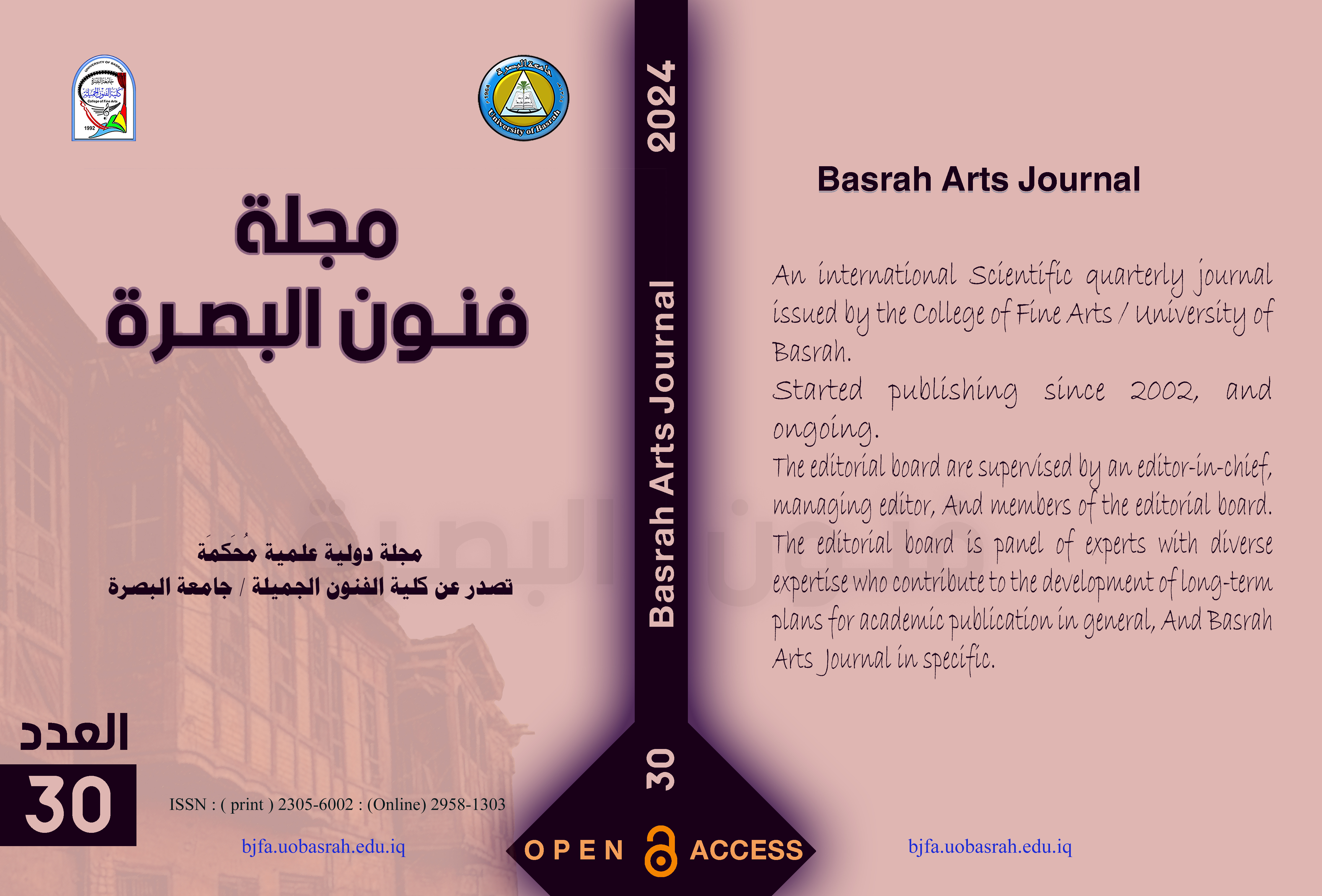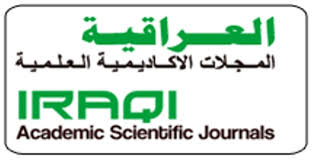Encoding format transformations in contemporary formation
DOI:
https://doi.org/10.59767/2024.08/30.4Keywords:
format, encryption, declaration, contemporary formationAbstract
The research dealt with the topic (transformations of coding format in contemporary art) with regard to the path of the contemporary artist and the importance of his connection to his society. The research problem was determined by answering the following question: (What are the hypothetical requirements for the mind to carry out an aesthetic reading of the various art formats?)
As for the second chapter, it included the theoretical framework, which contained two sections, the first included (the concept of communicative codes), while the second section included (the diversity of contemporary formation codes), while the third chapter was concerned with research procedures, and the fourth chapter contained the results and conclusions.
References
", ". A. (n.d.). www.arcadia.com Artists Database>K> Kindermann K-King.
Abbas, M. A., & Al-kinani, A. A. (2022). Intellectual Implications of the Duality of Mother and Child in the Social Perspective. Journal for Educators, Teachers and Trainers(4), pp. 229–237. doi:https://doi.org/10.47750/jett.2022.13.04.032
Abdullah, A. S. (2013). Technical data for building creative achievement in contemporary plastic arts. Basra: University of Basra.
Admir, K. (1997). In the book: The Semiotics of Prague for Theater, Semiotic Studies. Damascus: Ministry of Culture.
Ahmed, J. M. (2014). Contemporary Epistemology and the Structuralism of Post-Modern Fine Arts. Iraq: Library of Arts and Letters for Printing, Publishing and Distribution.
Al-Badri, A. F. (1999). The Transformative in Contemporary Iraqi Art (unpublished doctoral thesis ed.). University of Babylon.
Al-Bustani, M. (1992). Islam and Art (Vol. 1). Beirut, Lebanon: Islamic Research Academy for Studies and Publishing.
Aldaghlawy, H. (2024). Visual rhythm in the Iraqi theatrical performance. Journal of Arts and Cultural Studies, 3(1), 1-9. doi:https://doi.org/10.23112/acs24021201
Aldaghlawy, H. J. (2021). color connotations with costumes in the performances of the school theater. Oman: Cambridge Scientific Journal. doi:https://doi.org/10.5281/zenodo.7787343
Al-Mashhadani, T. S. (2003). Intellectual and aesthetic concepts for employing materials in post-modern art. Babylon.
Al-Qara Ghouli, M. A. (2006). Design aesthetics in postmodern drawings. Babylon: University of Babylon.
Alwani, R. K. (2008). Conceptual and aesthetic dimensions of the marginalized in postmodern art,. Babylon: University of Babylon, College of Fine Arts.
Amhaz, M. (2009). Contemporary Artistic Currents (Vol. 2). Beirut: Publications Company for Distribution and Publishing.
Amin, A. Z. (1970). The Story of Greek Philosophy. Cairo: Authorship and Translation Committee Publishing Press.
Antony, E. (n.d.). Abstract Expressionism.
Aristotle’s. (n.d.). The Art of Poetry. (D. I. Hamadeh, Trans.) Anglo-Egyptian Library.
Asfour, J. (1983). The Artistic Image (Vol. 2). Beirut, Lebanon: Dar Al-Tanweer.
Bankrad, S. (2005). Semiotics, its concepts and applications. Syria: Dar Al-Hiwar for Publishing and Distribution.
Boutros, A.-B. (B. T). Al-Muhit Dictionary (Volume Two ed.). Beirut: Lebanon Library.
Brooker, P. (1995). Modernism and Postmodernism (Vol. 1). (D. A. Alo, Trans.) Abu Dhabi, UAE: Cultural Foundation Publications.
Chomsky, N. (2005). Language, mind, and natural language (Vol. 1). (R. M. Khan, Trans.) Baghdad: House of General Cultural Affairs.
Edith, K. (1985). The Age of Structuralism from Lévi-Strauss to Foucault. (J. Asfour, Trans.) Baghdad: Arab Horizons Press and Publishing House.
Eric, F. (1995). The Forgotten Language - An Introduction to Understanding Dreams, Stories, and Myths (Vol. 1). (H. Qubaisi, Trans.) Casablanca: Arab Cultural Center.
Fadl, S. (1992). The Rhetoric of Discourse and the Science of Text. Kuwait: World of Knowledge Series, National Council for Culture, Arts and Letters.
Ferdinand, d. S. (1985). General Linguistics. (Y. Y. Aziz, Trans.) Baghdad: Arab Horizons House.
Hamid, S. A. (2009). magination from the Cave to Virtual Reality. Kuwait: World of Knowledge Series, Supreme Council for Culture, Literature and Arts.
https://www.virtualgallery.com/galleries/sergio_spinelli. (n.d.). Retrieved from massurrealism_56390.
Manzur, I. (D.T.). Lisan al-Arab. Egyptian: Egyptian House for Authorship and Translation, D.T., p. 384.
Murad, T. (2006). Art and Expression, Encyclopedia of Artistic Schools in Drawing (Vol. 1). Beirut, Lebanon: Al-Rateb University House.
Muslim, T. A. (2005). Cinematic Discourse - From Word to Image (Vol. 2). Baghdad, Baghdad: House of General Cultural Affairs.
Obersfeld, A. (1982). Reading Theater. (M. Al-Tilmisani, Trans.) Egypt: Supreme Council of Antiquities Press.
Qasim, S. a. (1986). Systems of signs in linguistics and literature, translated articles. Cairo: Dar Elias Al-Asriya.
Qatous, B. (2006). Introduction to Contemporary Criticism Methods. Alexandria: Dar Al-Wafaa for Printing and Publishing.
Reed, H. (1975). Raising artistic taste. (Y. M. Asaad, Trans.) Cairo: Dar Al-Nahda Al-Arabiyya.
Saeed, A. (1985). A Dictionary of Contemporary Literary Terms. Lebanon: Dar Al-Kitab Al-Lubani.
Shaker, A. H. (2005). The era of the image, the negatives and the positives (311 ed.). Epistemology.
Shawqi, G. (2004 ). The Intermediate Dictionary, Arabic Language Academy (Vol. 4). General Administration of Dictionaries and Heritage Revivals, Al-Sharq International Library.
Shuhaib, N. A. (2006). A Brief History of Art (Vol. 1). Amman, Jordan: Library of the Arab Complex for Publishing and Distribution.
Downloads
Published
How to Cite
License
Copyright (c) 2024 Muhanad Abdullah Jabbar, Fareed Khalid Alwan (Author)

This work is licensed under a Creative Commons Attribution 4.0 International License.







